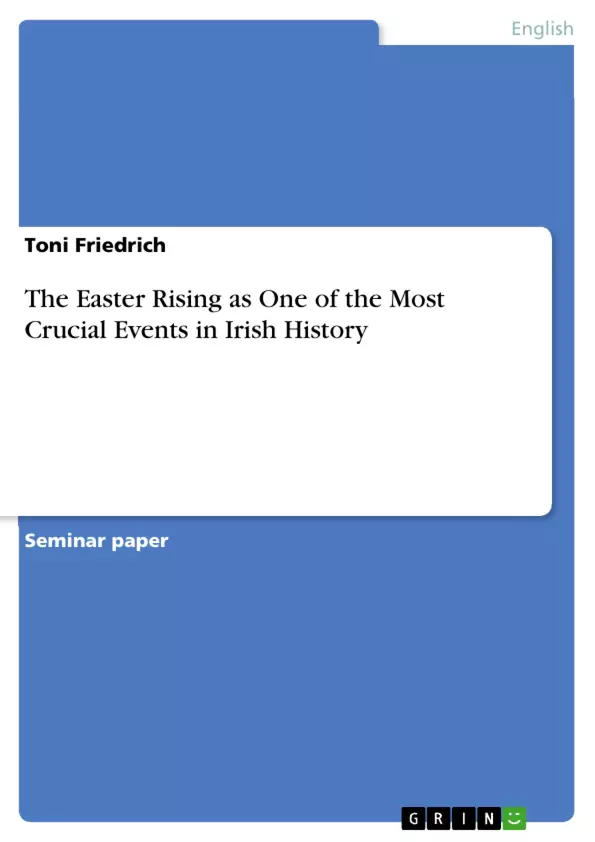The Easter Rising of national Irish rebels is still nowadays regarded as one of the most crucial events throughout Irish history. One may consider it as an botched attempt to gain sovereignty and disparage it to be an uprising that was senseless and doomed to failure in advance, others view it as a symbol of Irish martyrdom and as an insurgence that was anything but useless. Advocates claim that the Easter Rising was necessary to exercise pressure onto the British usurpators. They state that a military uprising like this, even if there was less prospect of success, showed Westminster that there could not be any long- term peace in Ireland without dealing with the question of home rule. Opponents argue that Irish rebels caused the loss of lives of innocent people by fighting a war that was at this time not backed up by the common Irish people, and that in the end they themselves are to be blamed for the casualties and devastation the fights demanded. Supporters reply that the insurrection was the first step to a free state of Ireland, that it stirred nationalism in the minds of the Catholics of the Island and that it was a milestone on the way to the republic.
Whatever scholars think of it, it is a matter of fact that this event is one of the most commemorated incidents in Ireland. Countless erected monuments and installed plates at places all over the Island reminisce of the losses and sacrifices of the 1916 rebels. They are called patriots who fought, outnumbered and starved, for a holy aim and who had to submit to ruthless soldiers, sent by an illicit and tyrannous foreign government. Therefore the uprising prevails in the mind of the Irish people, bolstered up by songs, poems or parades and days of commemoration.
This paper shall examine the circumstances right before the outbreak of the rising, its preparation and the course of events within it. Furthermore it intends to show in what way the British restored their power and how they responded to the open violence. The paper is supposed to try to display what aftermaths the Easter Rising actually had and if there was any sense in this adventure that was apparently doomed to failure in advance. Another point is concerned with the reflection of the rebellion. If it is blamed to be another example of useless hatred, conducted by only few men of weird mind, or if it is viewed as a necessary act of freedom by heroes who sacrificed themselves on the altar of a free Ireland.
Inhaltsverzeichnis (Table of Contents)
- Introduction
- Status quo ante - the circumstances before the outbreak
- Dissensions amongst nationalists
- Preparation for the rebellion
- The course of the Eastern Rising
- Restoration of British reign and punishment
- Political aftermaths of the Eastern Rising
- Summary
Zielsetzung und Themenschwerpunkte (Objectives and Key Themes)
This paper examines the circumstances leading up to the Easter Rising, its preparation, and the course of events within it. It also explores how the British restored their power and responded to the violence. The paper aims to analyze the aftermath of the Easter Rising, determine if it was a worthwhile endeavor, and assess its impact on Anglo-Irish history.
- The political and social context of Ireland before the Easter Rising
- The conflicting ideologies and objectives of Irish nationalists
- The impact of the Easter Rising on British rule in Ireland
- The lasting legacy of the Easter Rising in Irish history
Zusammenfassung der Kapitel (Chapter Summaries)
The first chapter provides an introduction to the Easter Rising and its significance in Irish history. It presents contrasting perspectives on the uprising, highlighting its role as a symbol of both Irish martyrdom and a misguided act of violence.
Chapter 2 delves into the circumstances leading up to the Easter Rising, examining the political and social tensions in Ireland and the influence of the First World War. It highlights the role of paramilitary organizations and the debate surrounding Home Rule.
Chapter 3 focuses on the divisions within the Irish nationalist movement, highlighting the conflict between John Redmond's moderate approach and the radicalism of Patrick Pearse and the Irish Republican Brotherhood.
Chapter 4 will likely discuss the preparations for the rebellion, including the planning of the uprising and the recruitment of participants.
Chapter 5 will probably examine the events of the Easter Rising itself, detailing the course of the rebellion and the military actions taken by both sides.
Chapter 6 will likely focus on the British response to the uprising, including the restoration of British control and the punishment of rebels. It will potentially explore the methods employed by British authorities to quell the rebellion and the aftermath of the fighting.
Chapter 7 is expected to analyze the political consequences of the Easter Rising, including its impact on Irish politics and the long-term implications for Anglo-Irish relations.
Schlüsselwörter (Keywords)
This paper explores the Easter Rising in Ireland, focusing on the political and social context of the time, the motivations and actions of Irish nationalists, the role of the British government, and the lasting impact of the uprising on Irish history. Key terms include: Irish nationalism, Home Rule, Irish Volunteers, Irish Republican Brotherhood, Easter Rising, British rule in Ireland, Anglo-Irish relations, and the legacy of the rebellion.
- Quote paper
- Toni Friedrich (Author), 2007, The Easter Rising as One of the Most Crucial Events in Irish History, Munich, GRIN Verlag, https://www.grin.com/document/184584



